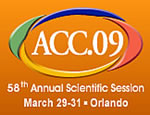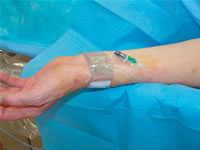|
Transradial
Angioplasty at ACC.09 and i2 Summit
Oral and Poster Presentations
from the 2009 American College of Cardiology Meeting Involving
the Transradial Approach to Catheter-Based Procedures
|
 |
 |
|
April
17, 2009 --
Following are summaries of all studies
concerning transradial access that were presented during the
American College of Cardiology 58th Annual Scientific Session
held March 29-31, 2009.
There was a single 15 minute oral contribution
made on the last day, and six poster presentations, made as
part of the i2 Summit. |
The take-away message from these studies was
that the radial approach is comparable in success rate to the femoral
with significantly lower
complications. Radial access also makes possible same-day discharge
of patients after stenting.
ACC.Oral Contributions -- Hot Topics
in Percutaneous Coronary Intervention
A Randomized Comparison of Transradial Versus Transfemoral
Approach for Coronary Angiography and Angioplasty
Presentation Time: Tuesday, Mar 31, 2009, 10:30 AM -10:45 AM
Martin Brueck, Dirk Bandorski, Wilfried Kramer, Harald Tillmanns, Clinic of Wetzlar,
Wetzlar, Germany
Background: Coronary angiography and angioplasty
are usually performed via the transfemoral approach. Transradial access
may offer some advantages in comparison with transfemoral access especially
under conditions of aggressive anticoagulation and antiplatelet treatment,
increasingly used in today's complex interventions. The aim of this
study was to evaluate the safety, feasibility and efficacy by the transradial
approach compared to the transfemoral access in a standard population
of patients undergoing coronary angiography and angioplasty.
Methods: Between July 2006 and January 2008,
1024 patients were randomly assigned to transradial or transfemoral
approach. Patients with an abnormal Allen test or history of coronary
artery bypass surgery were excluded. Both groups were comparable concerning
baseline clinical characteristics (age, sex, body mass index, cardiovascular
risk factors, acute and recent myocardial infarction, LV ejection fraction,
previous PCI). Procedures were performed by four experienced physicians.
Results:
|
Transfemoral (n=512) |
Transradial (n=512) |
p-value |
| Catheterization
success |
511 (99.9%) |
494 (96.5%) |
<0.0001 |
| Cross over |
1 (0.001%) |
18 (3.5%) |
<0.0001 |
| Angioplasty |
192 (37.5%) |
178 (34.8%) |
NS |
| Procedural success |
191 (99.5%) |
172 (96.6%) |
NS |
| Duration of procedure
(min) |
37.0 + 25.9 |
40.2 + 25.8 |
<0.05 |
| Contrast dye (ml) |
128.8 + 65.0 |
132.0 + 76.0 |
NS |
| Radiation exposure
(Gycm2) |
38.21 + 26.26 |
41.85 + 29.69 |
<0.05 |
| Fluoroscopy time
(min) |
5.79 + 5.96 |
9.02 + 8.65 |
<0.01 |
| Vascular complications |
19 (3.7%) |
3 (0.6%) |
0.001 |
Conclusions: The
finding of the present study shows that transradial coronary angiography
and angioplasty are safe, feasible and effective with similar results
to those of the transfemoral approach. However, using the transfemoral
approach, procedural duration, fluoroscopy time and radiation exposure
were higher, and vascular complications were seen in 4 patients
out of a hundred. In contrast, the rate of major vascular complications
was negligible using the transradial access.
i2 Poster Contributions (summarized)
2503-570/570. A Clinical Risk Prediction Tool for Post-PCI
Bleeding From the National Cardiovascular Data Registry® (NCDR®)
Jason B. Lindsey, Sameer K. Mehta, Andrew D. Frutkin, John A. Spertus, Sunil
V. Rao, Fang-Shu Ou, Matthew T. Roe, Eric D. Peterson, Steven P. Marso -- Mid
America Heart Institute, Kansas City, MO, Duke Clinical Research Institute,
Durham, NC
Summary: Bleeding after percutaneous coronary
intervention (PCI) is associated with increased morbidity and mortality.
The authors developed a clinical tool to estimate bleeding risk
in order to help physicians tailor peri-PCI therapy and reduce
risk. Authors used the NCDR® database. 440 centers from
the years 2004-06 were examined. Bleeding was defined as resulting
in transfusion, increased
length of stay, and/or >3gm/dL decrease in hemoglobin occurring
at vascular entry site, retroperitoneal, gastrointestinal, genitourinary
or other location. There were 302,152 patients with a bleeding
rate of 2.4%. (Editor's note: These procedures were virtually
all done from the femoral approach. Previous studies using the
NCDR
database
have shown radial use for 2004-06 to be only 1-2%.) This tool
to estimate post-procedural bleeding risk is potentially actionable,
enabling physicians to consider alternative strategies in high
risk patients that are associated with lower rates of bleeding,
namely use of transradial approach to PCI, smaller sheath size
and alternative anticoagulation strategies.
 2503-576/576. Left Radial Versus Femoral Approach
in Primary Percutaneous Coronary Intervention - Prospective Comparison 2503-576/576. Left Radial Versus Femoral Approach
in Primary Percutaneous Coronary Intervention - Prospective Comparison
Ivo Bernat, Jiri Koza, Jan Pesek, Jitka Tesarova, Richard Rokyta
-- University Hospital, Plzen, Czech Republic
Summary: Althought the right radial artery
is routinely used for coronary interventions,
90% of the population is right handed. The aim of this study was
to compare the left radial and femoral approach in primary
percutaneous
coronary intervention (PCI). In 2007,
297 consecutive patients with acute myocardial infarction (STEMI)
were treated by primary
PCI in the author's center. 255 were enrolled to
this prospective non randomized study: LR 129 pts versus (vs) FA
126 pts. Groups were similar
in age, gender, body mass index
and Killip class I (105 vs 107), II (21 vs 12), III (3 vs 7).
Procedural duration,
fluoroscopy time and technical
procedural success were
not significantly different between the groups. Contrast consumption
was lower in the left radial group.
Serious access site bleeding
complications occured only in the femoral group; none in the radial
group.
In hospital mortality was 2,3% in the left radial group and 4,0%
in the femoral group. The authors concluded that left radial approach
for primary PCI is safe, feasible and effective in STEMI patients
without
cardiogenic
shock.
Minimal
risk of serious
access site bleeding complications is the main advantage in comparison
with femoral approach. Postprocedural immediate normal right hand
mobility is
an added benefit for right handed patients.
2503-577/577. Quality of Life after Same-day
Discharge or Overnight Hospitalization after Transradial Coronary
Stenting and Maximal Antiplatelet
Therapy. Results of the Randomized EASY Trial
Olivier F. Bertrand, Javier Courtis, Stéphane Rinfret, Olivier
Costerousse, Éric Larose, Rodrigo Bagur, Helena Tizon-Marcos,
Can M. Nguyen, Robert De
Larochellière, Paul Poirier, Louis Roy, Josep Rodes-Cabau
-- Laval Hospital, Quebec Heart-Lung Institute, Quebec, QC, Canada
Summary: The EASY trial studied whether
same-day home discharge after PCI impacts differently health-related
quality of life (HRQOL)
measures
compared
to standard overnight hospitalization. 1,005 patients with acute
coronary syndrome (ACS) were randomized to be discharged home the
same-day (n=504) or after overnight stay (n=501) after transradial
coronary stenting and maximal antiplatelet therapy. Patients questionnaire
contaied 36 items that, when scored, yields 8 domains (physical
functioning, role physical, bodily pain, general health, vitality,
social functioning, role emotional, and mental health). All patients
were pretreated with
ASA and clopidogrel (90% > 12h) and received abciximab bolus prior
the first balloon inflation. The results were that whether the patient
was discharged the same day or overnight, there was no impact on
any of the measurements up through 12 months.
2503-574/574. Unsuccessful Transradial
Approach for Percutaneous Coronary Interventions: Predictors and
Mechanisms of Radial Access Failure
Payam Dehghani, Tony Hong, Colin M. Suen, Waseem Sharieff, Atif Muhammad, Robert
J. Chisholm, Michael J.B. Kutryk, Neil P. Fam, Asim N. -- Cheema, St. Michael's
Hospital, Toronto, ON, Canada
Summary: The authors studied 2,100 patients -- all
the patients undergoing transradial PCI at their center during 2002-2005 --
and attempted to determine the causes for those patients where the procedure
could not be completed via the radial artery. A total of 98 patients (4.7%)
experienced failure of the radial approach and were converted to femoral access
-- all but four of these conversions were successful. Radial access for PCI
in a diverse patient population was associated with a low rate of failure (<5%)
and a low rate of vascular complications (<1%). The predominant reasons
for radial failure were radial artery spasm, subclavian artery tortuosity,
and an anatomy with unsuitable back-up for PCI. Advanced age, previous CABG
and short stature were also independent predictors of radial failure.
2503-571/571.
Cerebral Embolism is Related to Access Site at Coronary Angiography
Juliane Jurga, Jesper Nyman, Nondita Sarkar, Per Tornvall, Maria N. Mannila,
Peter Svenarud, Jan van der Linden -- Dep of Cardiology, Karolinska University
Hospital, Karolinska Institutet, Stockholm, Sweden, Dep of Cardiothoracic Surgery
and Anesthesiology, Karolinska University Hospital, Karolinska Institu, Stockholm,
Sweden
Summary: Stroke is a rare but serious complication
of coronary angiography. Its cause is not entirely explained, but might be
related to the number of particulate emboli released by the catheter procedure.
This small study attempted to measure if the number of emboli was related
to the type of access site. The study randomized 50 patients to right femoral
or right radial access. The number of particulate emboli passing the cerebral
artery was measured using transcranial Doppler. The radial approach showed
significantly more emboli passing the right middle cerebral artery than the
femoral -- the left middle cerbral artery showed no differences between the
approaches. Changing of catheters was also associated with an increase in
emboli.
2503-572/572. Are Neurologic Complications
Following Percutaneous Coronary Diagnostic or Interventions more
Common in Transfemoral Versus Transradial Approach?
Helena Tizon-Marcos, Gerald Barbeau, Jacques Rouleau, Louis Roy, Onil Gleeton,
Guy Proulx, J-Pierre Dery, Olivier Bertand, CM Nguyen, Bernard Noel, Josep
Rodés-Cabau, Eric Larose, Stephane Rinfret, Robert De Larochellière
-- Laval Hospital, Quebec, QC, Canada
Summary: In contrast to the above study,
an analysis of 83,409 angiography or interventional procedures
from April 1990-October 2007 in this single-center retrospective
study showed that a cerebrovascular accident (CVA or stroke) was
an uncommon complication of both coronary angiography and interventions
-- it was observed in only 54 out of 83,409 patients (0.06%). However
the transadial approach was associated with a lower incidence of
per-procedural CVA than the transfemoral approach (0.049% vs 0.089%,
p= 0.029).
About the Radial Access Center on Angioplasty.Org
To assist in educating the professional and patient population in
the U.S. about the this technique, Angioplasty.Org has created
the "Radial
Access Center for Transradial Approach", a special section devoted
to information and news about the transradial technique, for both patients
and physicians. The Radial Center features interviews with leading practitioners
of the radial technique, such as Drs. Jeffrey Popma, R. Lee Jobe, John Coppola,
Shigeru Saito, Kirk Garratt and Howard Cohen.
For patients there is also a "Hospital
Locator" that lists U.S. centers practicing radial angiography.
Reported by Burt Cohen, April 17, 2009
|


 2503-576/576. Left Radial Versus Femoral Approach
in Primary Percutaneous Coronary Intervention - Prospective Comparison
2503-576/576. Left Radial Versus Femoral Approach
in Primary Percutaneous Coronary Intervention - Prospective Comparison